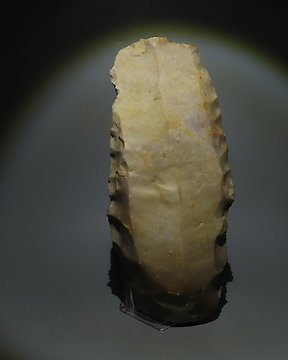
新石器時代 石 核“livres de beurre”。西元前 3000 - 2400 年。 31.5 公分長。
編號 84831241

編號 84831241

Eagle shaped vessel with lid.
- extremly fine -
- nice polished -
Nicoya - Guanacaste, Costa Rica · c. 300 - 500 AD
Green stone
7 cm length and 5 cm height.
PROVENANCE:
- Private collection, J. P. R., Vannes, France, 1960 - 1970.
- Art market, France.
- Private collection, Barcelona.
Condition: Very Good, intact. New rope.
Documents: With Spanish Export license.
The green stone was considered sacred in Mesoamerica; It was associated with water, the fertility of corn and life, therefore linking itself with the preservation of the agricultural cycle. Among these stones, the most appreciated was jade (jadeite), considered more valuable than gold and a key material at a religious, political and economic level throughout the region. It was reserved for the adornment of gods and kings, and even the latter could only wear it on certain occasions. Considered a symbol of life and purity, jade was especially used to make jewelry pieces such as pendants, nose rings or ear cuffs. Jadeite pendants were therefore highly prized objects, loaded with symbolic and religious meaning and only exhibited by the most powerful members of society.
Greater Nicoya is an archaeological region that covers northwest Costa Rica and the Pacific coast of Nicaragua. The Southern Subregion, or Guanacaste, occupies the Nicoya peninsula, the Tempisque River basin and the Guanacaste and Tilarán mountain ranges. This is an area with human occupation for about 10,000 years, and important remains of material culture in ceramics, carved stone and jade have already been found in the Tempisque period (500-300 BC). In the Bagaces period (300-800 AD) there was already a complex social organization that was reflected in a greater variety in burial formulas, which included the use of large stone blocks. Around the year 800, the territory of Guanacaste was occupied by Chorotega groups from the north, from the Valley of Mexico, who were fleeing Olmec domination. This migration will bring the cultural influence of the Mayans and form the germ of the Kingdom of Nicoya, one of the main pre-Columbian chiefdoms existing in Mesoamerica upon the arrival of the Spanish.
Notes:
- The piece includes authenticity certificate.
- The piece includes Spanish Export License.
- The seller guarantees that he acquired this piece according to all national and international laws related to the ownership of cultural property. Provenance statement seen by Catawiki.